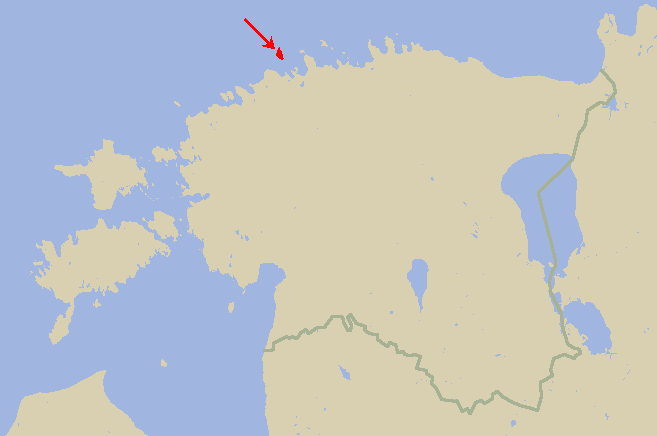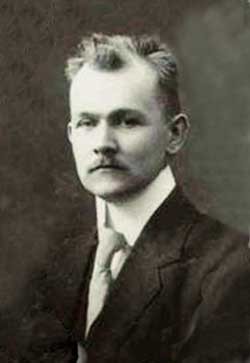|
Naissaar
Naissaar ( sv, Nargö; german: Nargen) is an island in Estonia. It is situated in the Gulf of Finland, northwest of the capital city Tallinn, and is administratively part of the Viimsi parish. The island covers an area of . It is long and wide, and lies about from the mainland. The highest point on the island is Kunilamägi, which is above sea level. The island consists predominantly of coniferous forest and piles of stones and boulders. In 2020, the island had a population of 17; in 2011 the island had 35 or so permanent residents and some summer residents. Administratively the island is divided into three villages: Lõunaküla (Storbyn), Tagaküla (Bakbyn), and Väikeheinamaa (Lillängin). Until World War II, the island's native population numbered about 450 people of Estonian-Swedish origin. However, all of the local residents fled from Naissaar to escape the 1944 Soviet invasion of Estonia. During the 1944–1991 Soviet occupation the island was used by the military ... [...More Info...] [...Related Items...] OR: [Wikipedia] [Google] [Baidu] |
Naissaar Lighthouse
__NOTOC__ Naissaar Lighthouse ( Estonian: ''Naissaare tuletorn'') is a lighthouse located on the Estonian island of Naissaar in the Gulf of Finland. History The first lighthouses on the island of Naissaar were built in 1788, consisting of beacons on the northernmost and southernmost points of the island. The deteriorating northernmost lighthouse was replaced by a limestone structure in 1849. This lighthouse was heavily damaged during the Crimean War, however it was reconstructed in 1856. The stone lighthouse was destroyed by Soviet troops in 1941, during World War II. Following the war, a temporary wooden lighthouse operated between 1946 and 1960, after which a 45-metre reinforced concrete lighthouse was built in its place. The lantern room was installed in 1999. The lighthouse stands as a landmark in the traditional style of Estonian lighthouses. It was automated, with the lighthouse's keeper leaving service in 2004. See also * List of lighthouses in Estonia This is a l ... [...More Info...] [...Related Items...] OR: [Wikipedia] [Google] [Baidu] |
Stepan Petrichenko
Stepan Maximovich Petrichenko (russian: link=no, Степа́н Макси́мович Петриче́нко; 1892 – June 2, 1947) was a Russian revolutionary, an anarcho-syndicalist politician, the head of the Soviet Republic of Soldiers and Fortress-Builders of Nargen and in 1921, ''de facto'' leader of the Kronstadt Commune, and the leader of the revolutionary committee which led the Kronstadt rebellion of 1921. Life Early years Stepan Maximovich Petrichenko was born in 1892 in the village of Nikitenka in the Zhizdrinsky Uyezd of Kaluga Governorate to a family of peasants. Two years after his birth, his family moved to Alexandrovsk (Yekaterinoslav Governorate), where Stepan graduated from city school and joined the local ironworks as a metalworker. In 1913 Petrichenko was called up for military service with the Russian navy, where he was assigned to the Russian battleship ''Petropavlovsk'', part of the Baltic Fleet. Soviet republic of sailors and builders During ... [...More Info...] [...Related Items...] OR: [Wikipedia] [Google] [Baidu] |
Bernhard Schmidt
Bernhard Woldemar Schmidt (, Nargen – 1 December 1935, Hamburg) was an Estonian optician. In 1930 he invented the Schmidt telescope which corrected for the optical errors of spherical aberration, coma, and astigmatism, making possible for the first time the construction of very large, wide-angled reflective cameras of short exposure time for astronomical research. Childhood Schmidt was the son of Carl Constantin and Marie Helene Christine ( Rosen) Schmidt. He was born and grew up on the island of Nargen (Naissaar), off the coast of Reval (Tallinn), Estonia, then part of the Russian Empire. The inhabitants of this island, mainly Estonian Swedes, generally spoke Swedish or Estonian, but the Schmidt family also spoke German. Bernhard was the oldest of six children, three boys (one of whom died in infancy) and three girls. Naissaar was a small, rural island whose population mainly supported themselves through fishing and piloting ships into the port of Reval. With his younger b ... [...More Info...] [...Related Items...] OR: [Wikipedia] [Google] [Baidu] |
Terra Feminarum
Terra feminarum ("''Women's Land''") is a name for an area in Medieval Northern Europe that appears in ''Gesta Hammaburgensis Ecclesiae Pontificum'' (Deeds of Bishops of the Hamburg Church) by Adam of Bremen 1075 AD. ''Terra Feminarum'' in ''Gesta'' "Woman Land", terra feminarum, appears four times in various chapters of ''Gesta Hammaburgensis Ecclesiae Pontificum'' (Deeds of Bishops of the Hamburg Church) by Adam of Bremen in 1075 AD. :''"In the meantime Swedes (Sueones), that had expelled their bishop, got a divine revenge. And at first King's son called Anund, whose father had sent him to enlarge his kingdom, after arriving to Woman Land (patriam feminarum), whom we consider to be Amazons, was killed along with his army from poison, that they had mixed to the spring water." (III 15)'' :''"After that come the Swedes (Sueones) that rule wide areas up until Woman Land (terram feminarum). Living east of these are said to be Wizzi, Mirri, Lamiy, Scuti and Turci up until the border ... [...More Info...] [...Related Items...] OR: [Wikipedia] [Google] [Baidu] |
Russian Cutter Opyt (1806)
The Russian cutter ''Opyt'' (also ''Apith''; – Experience) was launched in 1806. The British 44-gun frigate captured ''Opyt'' in 1808 in the Baltic during the Anglo-Russian War (1807-1812) after her captain and crew put up a heroic resistance. The Admiralty took her into service as HMS ''Baltic''. She served briefly with the British fleet under Vice-Admiral Sir James Saumarez in the Baltic before being sold in 1810. Russian service ''Opyt'' was a purpose-built cutter that cruised in the Baltic in 1807. On 1808 she arrived at Sveaborg from Kronshtadt to join the division under Captain of 2nd rank Lodewijk van Heiden (who went on to become the Russian Admiral at the Battle of Navarino in 1827), to help in the city's defense. On ''Opyt'' put to sea in company with the sloop-of-war ''Charlotta'' to cruise between Sveaborg and Hanko. During this cruise the two vessels became separated. ''Opyt'' returned to Sveaborg and was sent to find ''Charlotta'', but before she could ... [...More Info...] [...Related Items...] OR: [Wikipedia] [Google] [Baidu] |
Gulf Of Finland
The Gulf of Finland ( fi, Suomenlahti; et, Soome laht; rus, Фи́нский зали́в, r=Finskiy zaliv, p=ˈfʲinskʲɪj zɐˈlʲif; sv, Finska viken) is the easternmost arm of the Baltic Sea. It extends between Finland to the north and Estonia to the south, to Saint Petersburg in Russia to the east, where the river Neva drains into it. Other major cities around the gulf include Helsinki and Tallinn. The eastern parts of the Gulf of Finland belong to Russia, and some of Russia's most important oil harbors are located farthest in, near Saint Petersburg (including Primorsk). As the seaway to Saint Petersburg, the Gulf of Finland has been and continues to be of considerable strategic importance to Russia. Some of the environmental problems affecting the Baltic Sea are at their most pronounced in the shallow gulf. Proposals for a tunnel through the gulf have been made. Geography The gulf has an area of . The length (from the Hanko Peninsula to Saint Petersburg) is and ... [...More Info...] [...Related Items...] OR: [Wikipedia] [Google] [Baidu] |
Viimsi Parish
Viimsi Parish ( et, Viimsi vald) is a rural municipality in Northern Estonia, located North-East and neighbouring the capital Tallinn. It occupies an area of with a population of 20 580 (). The municipality contains the Viimsi Peninsula and several islands, including Naissaar, Prangli, and Aksi. The mayor of Viimsi Parish is Illar Lemetti. Divisions There are two small boroughs () and 20 villages () in Viimsi Parish. Small boroughs Viimsi and Haabneeme. Villages Äigrumäe, Idaotsa, Kelnase, Kelvingi, Laiaküla, Leppneeme, Lõunaküla (Storbyn), Lubja, Lääneotsa, Metsakasti, Miiduranna, Muuga, Pringi, Pärnamäe, Püünsi, Randvere, Rohuneeme, Tagaküla (Bakbyn), Tammneeme, Väikeheinamaa (Lillängin). Religion International relations Twin towns — Sister cities Viimsi Parish is twinned with: * Barleben, Germany * Porvoo, Finland * Ski Municipality, Norway * Sulejówek, Poland * Täby Municipality, Sweden * Ramat Yishai, Israel See also * Viimsi JK ... [...More Info...] [...Related Items...] OR: [Wikipedia] [Google] [Baidu] |
Great Northern War
The Great Northern War (1700–1721) was a conflict in which a coalition led by the Tsardom of Russia successfully contested the supremacy of the Swedish Empire in Northern, Central and Eastern Europe. The initial leaders of the anti-Swedish alliance were Peter I of Russia, Frederick IV of Denmark–Norway and Augustus II the Strong of Saxony– Poland–Lithuania. Frederick IV and Augustus II were defeated by Sweden, under Charles XII, and forced out of the alliance in 1700 and 1706 respectively, but rejoined it in 1709 after the defeat of Charles XII at the Battle of Poltava. George I of Great Britain and the Electorate of Hanover joined the coalition in 1714 for Hanover and in 1717 for Britain, and Frederick William I of Brandenburg-Prussia joined it in 1715. Charles XII led the Swedish army. Swedish allies included Holstein-Gottorp, several Polish magnates under Stanislaus I Leszczyński (1704–1710) and Cossacks under the Ukrainian Hetman Ivan Mazepa (1708 ... [...More Info...] [...Related Items...] OR: [Wikipedia] [Google] [Baidu] |
Single-ship Action
A single-ship action is a naval engagement fought between two warships of opposing sides, excluding submarine engagements; called so because there is a single ship on each side. The following is a list of notable single-ship actions. Single-ship actions Anglo-Spanish War * 1579, March 1 – ''Golden Hind'' captures the Spanish galleon ''Nuestra Señora de la Concepción''. Golden Age of Piracy * 1720, October 20 – British sloop ''Snow-Tyger'' under Jonathan Barnet captures the pirate sloop ''William'' and its owner Calico Jack. War of the Austrian Succession * 1743, June 20 – captures the Spanish treasure galleon ''Nuestra Señora de la Covadonga'' * 1746, 21 January – captures the French privateer ''Marianne'' Seven Years War * 1761, 1 January – captures the French merchant frigate ''Bien Aimé''. American Revolutionary War * 1776, July 27 – and have an inconclusive engagement * 1777, 12 July – British merchantman ''Pole'' repulses the privateer ''Ameri ... [...More Info...] [...Related Items...] OR: [Wikipedia] [Google] [Baidu] |
Eesti Naissaar
Estonia, formally the Republic of Estonia, is a country by the Baltic Sea in Northern Europe. It is bordered to the north by the Gulf of Finland across from Finland, to the west by the sea across from Sweden, to the south by Latvia, and to the east by Lake Peipus and Russia. The territory of Estonia consists of the mainland, the larger islands of Saaremaa and Hiiumaa, and over 2,200 other islands and islets on the eastern coast of the Baltic Sea, covering a total area of . The capital city Tallinn and Tartu are the two largest urban areas of the country. The Estonian language is the autochthonous and the official language of Estonia; it is the first language of the majority of its population, as well as the world's second most spoken Finnic language. The land of what is now modern Estonia has been inhabited by ''Homo sapiens'' since at least 9,000 BC. The medieval indigenous population of Estonia was one of the last " pagan" civilisations in Europe to adopt Christianity ... [...More Info...] [...Related Items...] OR: [Wikipedia] [Google] [Baidu] |



